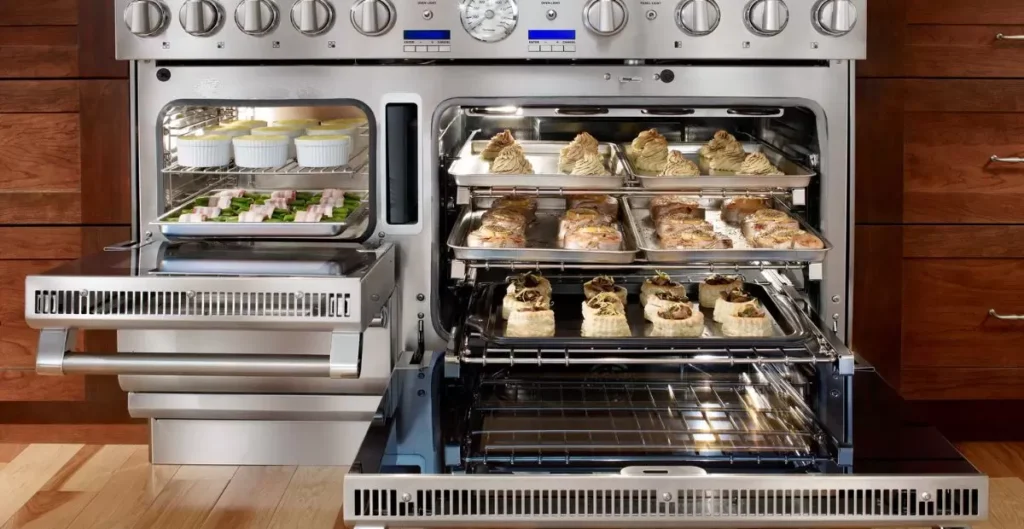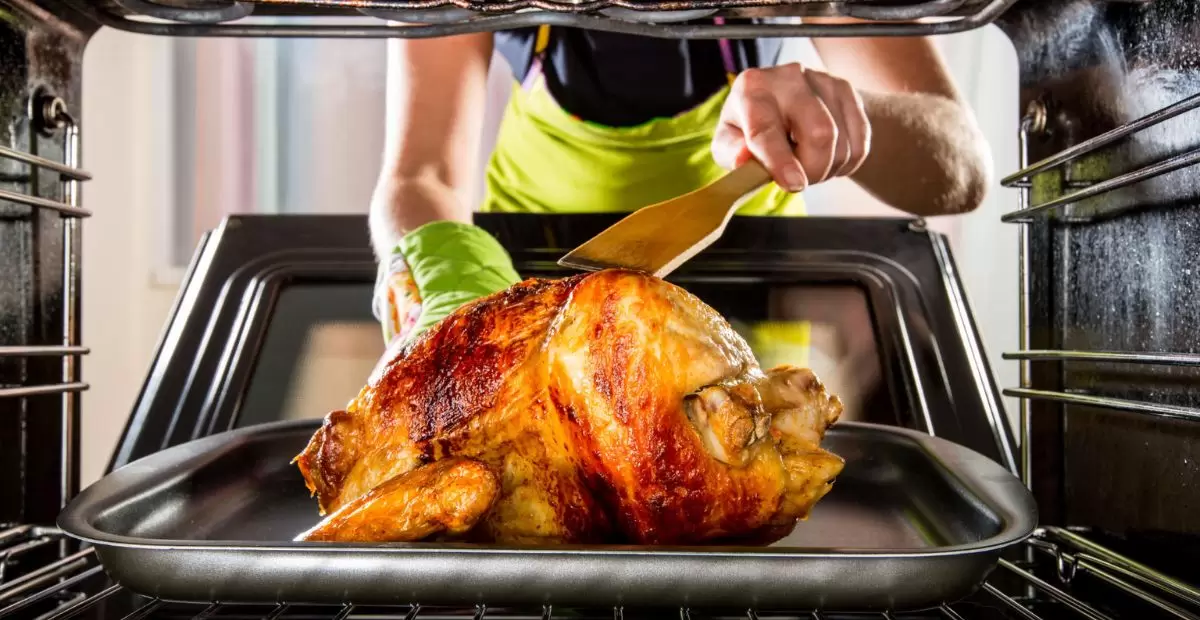The Oven is a kitchen appliance designed for baking, roasting, and heating food. It typically consists of a compartment with a heat source and temperature controls. Ovens come in various types, including conventional ovens, convection ovens, and microwave ovens.
The question often crosses the minds of home cooks and those venturing into the culinary world. Discover in Can You Put Stainless Steel In The Oven? The use of stainless steel cookware has become increasingly popular, but its compatibility with the oven can be a source of uncertainty.
When it comes to putting stainless steel in the oven, it’s important to consider the specific type of stainless steel and the intended use. Many stainless steel pans and bakeware are oven-safe up to a certain temperature. It’s crucial to check the manufacturer’s guidelines to ensure safe usage.
Key properties that make stainless steel popular in the kitchen
Stainless steel’s popularity in the kitchen stems from its remarkable properties. Renowned for its durability, stainless steel is resistant to rust, corrosion, and stains, making it an ideal choice for cookware. Its non-reactive nature ensures that it won’t impart unwanted flavors to food, preserving the integrity of the dish.
Stainless steel is also known for even heat distribution, preventing hot spots during cooking. This feature is particularly advantageous when using stainless steel pots and pans on stove tops and in ovens, as it helps achieve consistent results. The material is non-porous and easy to clean, making it a favorite among chefs for its reliability and low-maintenance characteristics.
How to identify if your stainless steel cookware is oven-safe
Determining the oven-safety of your stainless steel cookware is crucial for avoiding potential mishaps. To begin, examine the product’s packaging and labels for any indications of oven compatibility. Manufacturers often provide clear information on whether the cookware is safe for oven use and specify the maximum temperature it can withstand.
If the packaging is not available or lacks detailed information, turn to the user manual or product documentation. Another reliable method is to inspect the cookware itself for specific oven-safe labels or symbols. Look for markings such as oven-safe or temperature limits engraved or printed on the handles or bottom of the cookware.
Safe temperature ranges for stainless steel in the oven
When it comes to using stainless steel in the oven, understanding the safe temperature ranges is crucial for successful and risk-free cooking. Most stainless steel cookware is designed to withstand a broad spectrum of temperatures, making it versatile for various culinary applications.
Oven-safe stainless steel can endure temperatures up to 500°F (260°C) or more, ensuring it can handle baking, roasting, and broiling with ease. It’s essential to consult the manufacturer’s guidelines for specific temperature recommendations, as different types of stainless steel may have varying heat tolerances.
Potential risks of exceeding recommended temperatures
While stainless steel is known for its durability, exceeding recommended temperature limits in the oven can pose risks to both the cookware and the food being prepared. High temperatures can lead to warping or distortion of the stainless steel, affecting its structural integrity over time.
Cooking at excessively high temperatures may cause discoloration or damage to the outer finishes of the cookware. Beyond the impact on the cookware itself, exceeding temperature limits can also affect the quality of your dishes, leading to uneven cooking, burning, or undesirable changes in texture.
Varieties of stainless steel and their suitability for oven applications

Stainless steel comes in various grades, each with its own unique properties that affect its performance in the oven. The most common types are 18/10, 18/8, and 18/0, referring to the percentages of chromium and nickel present. The 18/10 stainless steel, containing 18% chromium and 10% nickel, is often regarded as the best for oven use due to its corrosion resistance and durability.
When it comes to cleaning stainless steel jewelry, the choice of alloy matters. Opt for 18/10 stainless steel, ideal for its durability and resistance to corrosion. This makes it suitable for a wide range of cooking applications, from roasting to baking. On the other hand, 18/0 stainless steel, with no nickel content, is more prone to corrosion but can still be oven-safe depending on the specific cooking needs.
Factors to consider when selecting oven-safe stainless steel cookware
When choosing stainless steel cookware for oven use, consider the thickness of the material. Thicker stainless steel tends to distribute heat more evenly, preventing hot spots and promoting consistent cooking results. Look for cookware labeled as oven-safe or with specific temperature limits provided by the manufacturer.
Handles and lids are crucial factors, as they may have components like plastic or wood that could be damaged by high oven temperatures. It’s essential to opt for stainless steel cookware with handles and lids made from heat-resistant materials to ensure they can withstand the oven environment.
Precautions for Oven-Safe Stainless Steel
When considering stainless steel in the oven, it’s vital to take precautions to ensure a safe and successful cooking experience. Begin by meticulously inspecting your cookware for any non-metal components. Some stainless steel items may have handles, lids, or coatings made of materials that aren’t oven-friendly.
Make sure all parts are heat-resistant to avoid any mishaps during cooking. Pay special attention to the handles. While the main body of the cookware may be oven-safe, handles could be made of materials that don’t fare well in high temperatures. To prevent accidents, always check the specifications provided by the manufacturer.
Tips for optimal cooking results with stainless steel cookware
Achieving the best results with stainless steel in the oven involves a few key tips. Firstly, ensure that your stainless steel cookware is preheated before placing food in it. This helps in achieving an even and consistent temperature, contributing to better cooking outcomes. Using an appropriate amount of oil can prevent sticking and enhance the flavor of your dishes.
Giving your food enough space allows for proper heat circulation, ensuring that everything cooks uniformly. When it comes to cleaning, avoid using abrasive materials that could damage the stainless steel surface. Instead, opt for gentle cleaning methods to maintain the cookware’s integrity and longevity.
Enhancing the durability and longevity of your kitchen tools
Taking care of your stainless steel kitchen tools is essential for ensuring their durability and longevity. After each use, make it a habit to hand wash your stainless steel cookware with mild dish soap and warm water. Avoid using abrasive scrubbers or harsh chemicals, as they can damage the stainless steel surface and compromise its integrity.
Proper storage is another key factor in maintaining the quality of your kitchen tools. Store stainless steel items in a dry and well-ventilated area to prevent moisture buildup, which could lead to rust over time. If stacking your cookware, place a soft liner between items to prevent scratches.
Clarifying misunderstandings to ensure safe cooking practices
There are common misconceptions surrounding the use of stainless steel in the oven, and it’s crucial to clarify them for safe cooking practices. Contrary to some beliefs, not all stainless steel cookware is oven-safe. Always check the manufacturer’s guidelines to confirm the specific temperature limits and usage recommendations for your stainless steel items.
Some also believe that all stainless steel handles are heat-resistant, but this is not universally true. Verify the handle material and temperature resistance before exposing it to high heat. By dispelling these misunderstandings and adhering to proper usage guidelines, you can confidently incorporate stainless steel into your oven cooking routine.
Cleaning and caring for stainless steel after oven use
After whipping up a delectable dish in the oven using your trusty stainless steel cookware, it’s time to show your kitchen companions a little TLC. Start by allowing the cookware to cool slightly before diving into the cleaning process. A gentle hand wash with mild dish soap and warm water is the go-to method for preserving the shine and integrity of your stainless steel.
Avoid abrasive scrubbers or harsh chemicals, as these can leave unsightly scratches or damage the stainless steel’s protective layer. To maintain that sparkling finish, consider using a mixture of white vinegar and water for a final rinse, leaving your stainless steel ready for its next culinary adventure.
As for long-term care, make friends with a soft cloth and a dab of olive oil. Apply a thin layer of oil to the surface of your stainless steel cookware to prevent discoloration and maintain its natural luster. Store your stainless steel items in a dry, well-ventilated space to prevent any moisture-related issues.
Versatile options for different oven-based cooking techniques
When it comes to harnessing the full potential of stainless steel in the oven, versatility is the name of the game. For baking enthusiasts, stainless steel baking sheets and pans offer even heat distribution, ensuring that cookies, pastries, and roasts are cooked to perfection. Stainless steel roasting pans are not just for Thanksgiving turkey, they’re also ideal for succulent chicken, vegetables, and one-pan meals.
Embrace the broil setting with stainless steel broiler pans, perfect for achieving that coveted caramelized crust on your favorite dishes. When experimenting with different oven-based cooking techniques, stainless steel’s durability and heat-resistance make it an ideal choice, whether you’re grilling, roasting, baking, or broiling.
FAQs
Can I use stainless steel dishes in an electric oven?
Yes, you can generally use stainless steel dishes in an electric oven, but it’s essential to check the manufacturer’s guidelines and ensure the specific cookware is labeled as oven-safe.
Is all stainless steel oven-safe?
Stainless steel cookware varies, and not all types are oven-safe. Check the manufacturer’s guidelines to ensure your specific stainless steel items can withstand oven temperatures.
Can I use any stainless steel pan in the oven?
While many stainless steel pans are oven-safe, it’s essential to confirm each product’s specifications. Check for oven-safe labels, and be cautious if the pan has non-metal components like handles or lids.
What should I avoid when using stainless steel in the oven?
Avoid exceeding the recommended temperature limits for your stainless steel cookware. Be mindful of plastic or wooden components that may not be oven-safe and could compromise the integrity of the cookware.
Conclusion
In the kitchen, stainless steel proves to be a reliable companion in the oven. By understanding the nuances of stainless steel cookware and adhering to the recommended guidelines, you unlock a world of culinary possibilities. Whether baking, roasting, or heating, the versatility of stainless steel shines through.
Check for oven-safe labels, respect temperature limits, and choose the right stainless steel for your cooking adventures. With a dash of caution and a pinch of knowledge, you can confidently embrace the use of stainless steel in the oven, transforming ordinary meals into extraordinary culinary delights.
